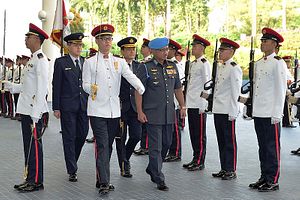As I have noted before, over the past few years, Malaysia has been grappling with the rather grim reality of a military that needs urgent modernization amid rising manifold threats on the one hand and a political and economic environment that is not conducive to funding much-needed capability boosts on the other (See: “What Does Malaysia’s New Defense Budget For 2016 Mean?”).
New defense programs and even some capabilities mulled to help close gaps had been shelved due to budgetary constraints; last year’s defense budget saw the largest cut since 1998 when Malaysia was reeling from the Asian Financial Crisis (See: “Where Are Malaysia’s New Warships in its Military Modernization?”). And with the country gearing up for elections within the next year or so, major new acquisitions are less likely to be made in the immediate future.
The Royal Malaysian Air Force (RMAF) is not immune to these challenges. And unless things change dramatically for the better, Air Force Chief Affendi Buang, who was appointed last December in a series of key reshuffles in the country’s armed forces, will have to face all this during his tenure (See: “Malaysia’s New Air Force Chief Makes First Singapore Visit”).
Earlier this month, just before the Paris Air Show, Affendi spoke to Shepherd Media about the new military equipment that the RMAF is prioritizing, subject, of course, to the availability of funding allocations by the Malaysian government.
The list of new items, as opposed to ongoing upgrades, is not entirely surprising. One of the key items on it is new maritime patrol aircraft (MPA). As I have noted before, that is an acquisition that would make sense. Even though Malaysia’s Beechcraft B200T aircraft do have maritime patrol capabilities, these are aging aircraft and the country needs more planes and ships to monitor its vast waters.
There had been reports earlier this year that Japan might give used patrol aircraft to Malaysia, which Affendi dismissed as a potential rumor (See: “Will Japan Give Malaysia Maritime Patrol Aircraft?”). He told Shepherd Media that the RMAF is “considering a few options,” and is also looking at interim measures like modifying and integrating some of its CN325 medium transport aircraft with the AMASCOS surveillance system from the B200T.
Another item that was mentioned as a possibility was new multi-role combat aircraft (MRCA). The RMAF’s fleet consists of a mix of combat aircraft, including MiG-29s, Sukhoi Su-30s, and F/A-18Ds. Affendi said rather bluntly that with the MiG-29 fleet aging and technological advancements in areas like weaponry and sensor fusion, Malaysia was starting to see “an increase in capability gap.”
The MRCA replacement program has been talked about for years now, with serious doubts about whether it will be approved in the next year or two. BAE Systems’ Eurofighter Typhoon, Dassault’s Rafale, and Saab’s Gripen have been said to be the main contenders to meet Malaysia’s requirement for up to 18 new aircraft.
It was no surprise, then, that Affendi declined to elaborate on what exact response the RMAF had in mind, merely saying that the RMAF was being forced to consider “the available options” for future operations of the MiG-29 and that certain measures had been proposed to the Malaysian government.
Even as Affendi has quite clear about the constraints that Malaysia faces in acquiring these new equipment, he has been equally blunt about its capability gaps in this as well as in other engagements. For instance, on the sidelines of the Paris Air Show, he told Malaysia’s national news agency Bernama that the acquisition of new, highly-capable assets was an even greater priority now following the inking of the trilateral patrol agreement with Indonesia and the Philippines (See: “What’s Next for the New Sulu Sea Trilateral Patrols?”).

































